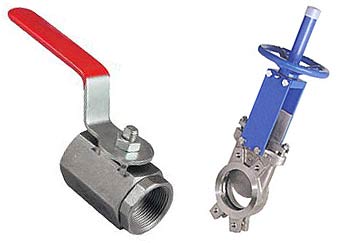Pipe Valves
Pipe valves are a popular category in pipe fittings. Pipe valves are mechanisms or devices to regulate or control the flow of liquid or gas within a pipe. While some valves are used to regulate the rate of flow, there are others that are used to stop it completely in order to prevent flooding or allow repairs to be made.
There are varieties of pipe valves in various materials, sizes and finish , and each type of valve performs a specific task. Pipe valves are known by various names like faucets, stops, bibs, taps, cocks or even drains. They can be easily custom-made for specific applications.
Buying TipsEach type of pipe valve has its own advantages,
and to select a proper valve for a particular application is
critical. The factors to be considered in the selection of a pipe
valve are as follows:
Mechanical features:
- The required flow rate.
- The substance which is handled.
- The requirement that the pipe valve stop and/or control the
flow in the manner required by the service conditions.
- The ability of the pipe valve to bear the maximum working
pressure and temperature.
- The ability of the valve to withstand attack by corrosion or
erosion.
- Actuator requirements, if there is any.
- Properly joined in the leakage points.
- Maintenance and repair requirements.
Physical features:
- Size
- Service Pressures
- Service Temperatures
- End connections
- Body material
- Operations
- Patterns
- Color and Finish
- Durability
|
Materials used:

- Mild Steel
- Stainless Steel
- Bronze
- Gun Metal
- Cast Iron
- Forged Steel
- Carbon Steel
- Plastic
- Polypropylene
- Aluminum etc.
Valve connections:
There are a various methods used for connecting valves into the piping
systems. They are as follows:
- Flanges: Suitable rated flanges are provided with the
pipe valve.
- Wafer: The pipe valve is provided with suitable sealing
faces. It is trapped between line flanges.
- Butt Welded: The pipe valve is provided with butt weld
end. This is welded into the piping system using high integrity
joints.
- Socket Welded: These welds allow and weld into the piping
system using fillet welds.
- Screwed Ends: Ends of pipe valves can be provided with
female or male screwed ends . The threads can be parallel or
tapered.
- Compression Fittings: Ends of pipe valves can be provided
with compression fittings.
Possible leakage points on valves:
An important requirement in any pipe valve design is to reduce or
minimize the leakage of fluids/liquids into the surrounding environment.
Some leakage points in pipe valve which should be properly taken care of
are as follows:
- The piping's end connections.
- The spindle gland seals which allow rotary and axial motion.
- For top entry valves, a leakage point is the sealed top closure
joint.
- The two split joints for three piece ball valves.
- Valve drain connections.
- Vent connections.
|
Did you know?
The best option for reducing risk of leakage
from the pipe connections is to use butt welded joints. These can be
verified by non-destructive-testing (NDT). This eliminates the valve
types which have to be removed for maintenance.
|
Uses of pipe valves:
- They are designed for safe and easy plumbing.
- Pipe valves are engineered to the highest standard of repeatable
quality.
- They are ease of use and high performance.
- Pipe valves can be fitted with pneumatic or hydraulic actuators
for remote control.
- Pipe valves are manufactured for liquid and gas flow control in
chemical, petroleum, power generating and general industrial
applications.
Applications of pipe valves:
The pipe valve is suitable for use across a wide spectrum of
applications such as:
- Industrial water treatment
- Aquariums
- Swimming pools
- Water parks
- Waste water technology
- Potable water treatment
- Electroplating
- Power plants
- Chemical distribution etc.
Types of pipe valves:
Let us get to know more of pipe valves by studying the various types of
pipe valves which are popularly demanded in the market:
The points mentioned below will be a guide for the buyers:
